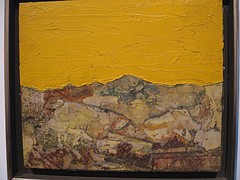America’s current economic recession was once described to me by a septuagenarian as “sissified” in comparison to the Great Depression. “There was no work anywhere,” he said. “All the work in the shipyards was completely stopped.” Maybe the median U.S. quality of life has increased so much since the 1930s that we just can’t understand what that Depression was like. There’s national dialogue about hunger and economic stagnation, but it’s not part of our landscape to see a crowd of the hungry lined up under dreary skies outside a soup kitchen.
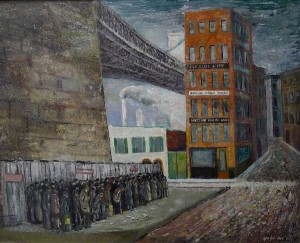
That era of history is brought vividly to life in “Jewish Artists in America: 1925-1945,” a showing of 21 paintings from the collection of Steven and Stephanie Wasser at the National Museum of American Jewish History in Old City. Not restricted to depictions of Jewish life, these paintings portray diverse subjects in the social realist style. The day-to-day minutiae of poverty are emphasized in these pieces, with the subjects often portrayed as the suffering proletariat, oppressed by unseen economic forces. But in Joseph Biel’s “Soup Kitchen,” the cheery advertising slogan on the brick wall opposite the malnourished –“A Cube Makes a Cup – Delicious Kitchen Products – Simply Add Boiling Water” – seems to represent a sinister capitalist’s laugh at the plight of the poor, like a macabre detail out of an Upton Sinclair novel.
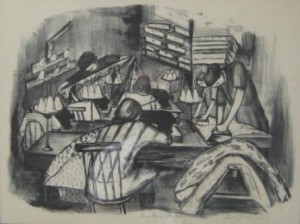
The Jewish artists in this show, all first- or second- generation immigrants from Eastern Europe, mostly worked as artists for the WPA (Roosevelt’s Works Progress Administration). But state-subsidized artists did not have easy lives. Artist Riva Helfond worked in hat and textile factories while studying at the Art Students League in New York before being hired by the WPA and establishing a printmaking program at the Harlem Art Center. Her painful memories of days of machine labor come through in “Curtain Factory,” where the women in a curtain workshop, all sharp angles and edges, resemble nothing more than prisoners.
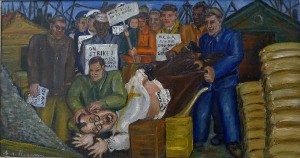
Sarah Berman Beach’s “Waterfront Strike” memorializes the West Coast Strike of 65,000 union longshoremen and other workers in San Francisco Bay in 1934, an event which is remembered as a failure and black eye for the unions of that era. Beach’s painting shows a crowd on the dock attacking J.P. Ryan – the leader elected to represent the dockworkers in negotiations and whose proposed settlement was rejected. A diverse crowd of dockworkers, including a mother and child, happily look on at the cartoonish Ryan figure’s (apparently fictional) beating. The distorted image seems to reflect Beach’s opinion of the confusion of workers in the labor movement of that era; satisfied with attacking their own leader, rather than their actual capitalist oppressors. Meanwhile, the machinery in the distant background and the stacked sacks of goods from overseas wall the workers in like animals in a cage. According to historical sources, the strike ended without the union’s demands being met, a loss in the war of wills which weakened their position for years to come.
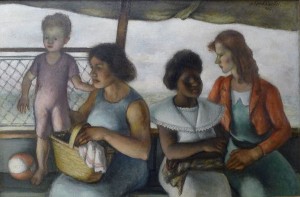
In “Island Beach Ferry,” a group of young women, each seemingly confined by a specific circumstance of concerns and fear, sits alongside each other on a ferry as a young American child smiles from a secret happiness at the viewer. Each woman represents a different ethnicity, and each aches from their own struggles of scraping together a living during the Depression — but somehow, they are making it. It’s worth nothing, however, that these artists, caught in their historical moment, had no idea that the Depression would end, or that the U.S. would go on to be more prosperous than ever. It’s easy to read these images retrospectively as hopeful depictions of people surviving a traumatic period, but perhaps more interesting and touching is the realization that these artists created images of hope without the certainty that these tough times would end.
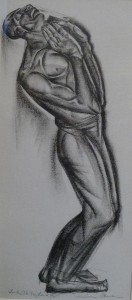
Iver Rose, a Chicago native, created Lord, Oh My Lord, a lithograph in this show where the nearly naked African-American subject presents an image of life resisting suffering and pain in every line. His posture, constrained by the dimensions of the composition, contrasts sharply with his muscled body, healthy and full of life. With an agonized facial expression and massive hands clasped together in mute supplication, this figure is praying for release – although whether from the economic suffering of the Depression or racial discrimination of the era is unclear.
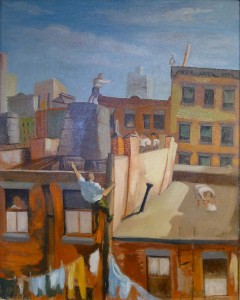
One piece where the spirit of the working class is celebrated as persevering in the face of adversity is Louis Ribak’s bright City Rooftops. The piece depicts a joyous moment above tenements where energy conducted between two figures scaling a building seems to point upward towards some kind of improvement or absolution.
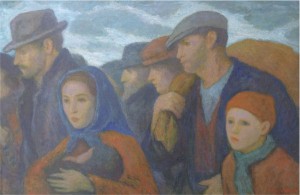
Even in the throes of the Great Depression, America still was a promised land for Eastern European immigrants seeking to escape oppression and cultural stagnation. As a result, the lens through which these painters saw the world is optimistic, even as it is sensitive to the sufferings of the common people. The general spirit of the confused but hopeful crowds who came to the U.S. during this era is best captured in this show by Julius Bloch’s painting The Emigrants, a simple painting which elegantly captures the mixed emotions of travelers coming to the United States. It’s only too bad that the National Museum of American Jewish History cannot provide more gallery space for this exhibition, as an even larger show would paint an even wider panorama of the troubled and perhaps too-little remembered lives that average people endured during the Depression.
“Jewish Artists in America: 1925-1945” will be on display at the National Museum of American Jewish History in Old City through June 20.



